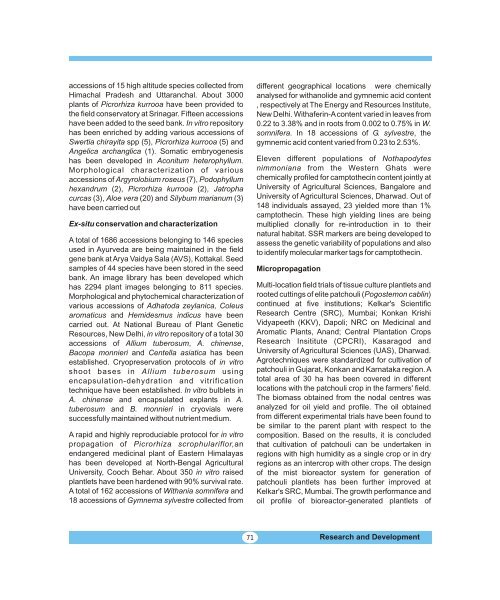ANNUAL REPORT - Department of Biotechnology
ANNUAL REPORT - Department of Biotechnology
ANNUAL REPORT - Department of Biotechnology
Create successful ePaper yourself
Turn your PDF publications into a flip-book with our unique Google optimized e-Paper software.
accessions <strong>of</strong> 15 high altitude species collected from<br />
Himachal Pradesh and Uttaranchal. About 3000<br />
plants <strong>of</strong> Picrorhiza kurrooa have been provided to<br />
the field conservatory at Srinagar. Fifteen accessions<br />
have been added to the seed bank. In vitro repository<br />
has been enriched by adding various accessions <strong>of</strong><br />
Swertia chirayita spp (5), Picrorhiza kurrooa (5) and<br />
Angelica archanglica (1). Somatic embryogenesis<br />
has been developed in Aconitum heterophyllum.<br />
Morphological characterization <strong>of</strong> various<br />
accessions <strong>of</strong> Argyrolobium roseus (7), Podophyllum<br />
hexandrum (2), Picrorhiza kurrooa (2), Jatropha<br />
curcas (3), Aloe vera (20) and Silybum marianum (3)<br />
have been carried out<br />
Ex-situ conservation and characterization<br />
A total <strong>of</strong> 1686 accessions belonging to 146 species<br />
used in Ayurveda are being maintained in the field<br />
gene bank at Arya Vaidya Sala (AVS), Kottakal. Seed<br />
samples <strong>of</strong> 44 species have been stored in the seed<br />
bank. An image library has been developed which<br />
has 2294 plant images belonging to 811 species.<br />
Morphological and phytochemical characterization <strong>of</strong><br />
various accessions <strong>of</strong> Adhatoda zeylanica, Coleus<br />
aromaticus and Hemidesmus indicus have been<br />
carried out. At National Bureau <strong>of</strong> Plant Genetic<br />
Resources, New Delhi, in vitro repository <strong>of</strong> a total 30<br />
accessions <strong>of</strong> Allium tuberosum, A. chinense,<br />
Bacopa monnieri and Centella asiatica has been<br />
established. Cryopreservation protocols <strong>of</strong> in vitro<br />
shoot bases in Allium tuberosum using<br />
encapsulation-dehydration and vitrification<br />
technique have been established. In vitro bulblets in<br />
A. chinense and encapsulated explants in A.<br />
tuberosum and B. monnieri in cryovials were<br />
successfully maintained without nutrient medium.<br />
A rapid and highly reproduciable protocol for in vitro<br />
propagation <strong>of</strong> Picrorhiza scrophulariflor,an<br />
endangered medicinal plant <strong>of</strong> Eastern Himalayas<br />
has been developed at North-Bengal Agricultural<br />
University, Cooch Behar. About 350 in vitro raised<br />
plantlets have been hardened with 90% survival rate.<br />
A total <strong>of</strong> 162 accessions <strong>of</strong> Withania somnifera and<br />
18 accessions <strong>of</strong> Gymnema sylvestre collected from<br />
71<br />
different geographical locations were chemically<br />
analysed for withanolide and gymnemic acid content<br />
, respectively at The Energy and Resources Institute,<br />
New Delhi. Withaferin-A content varied in leaves from<br />
0.22 to 3.38% and in roots from 0.002 to 0.75% in W.<br />
somnifera. In 18 accessions <strong>of</strong> G. sylvestre, the<br />
gymnemic acid content varied from 0.23 to 2.53%.<br />
Eleven different populations <strong>of</strong> Nothapodytes<br />
nimmoniana from the Western Ghats were<br />
chemically pr<strong>of</strong>iled for camptothecin content jointly at<br />
University <strong>of</strong> Agricultural Sciences, Bangalore and<br />
University <strong>of</strong> Agricultural Sciences, Dharwad. Out <strong>of</strong><br />
148 individuals assayed, 23 yielded more than 1%<br />
camptothecin. These high yielding lines are being<br />
multiplied clonally for re-introduction in to their<br />
natural habitat. SSR markers are being developed to<br />
assess the genetic variability <strong>of</strong> populations and also<br />
to identify molecular marker tags for camptothecin.<br />
Micropropagation<br />
Multi-location field trials <strong>of</strong> tissue culture plantlets and<br />
rooted cuttings <strong>of</strong> elite patchouli (Pogostemon cablin)<br />
continued at five institutions; Kelkar's Scientific<br />
Research Centre (SRC), Mumbai; Konkan Krishi<br />
Vidyapeeth (KKV), Dapoli; NRC on Medicinal and<br />
Aromatic Plants, Anand; Central Plantation Crops<br />
Research Insititute (CPCRI), Kasaragod and<br />
University <strong>of</strong> Agricultural Sciences (UAS), Dharwad.<br />
Agrotechniques were standardized for cultivation <strong>of</strong><br />
patchouli in Gujarat, Konkan and Karnataka region. A<br />
total area <strong>of</strong> 30 ha has been covered in different<br />
locations with the patchouli crop in the farmers' field.<br />
The biomass obtained from the nodal centres was<br />
analyzed for oil yield and pr<strong>of</strong>ile. The oil obtained<br />
from different experimental trials have been found to<br />
be similar to the parent plant with respect to the<br />
composition. Based on the results, it is concluded<br />
that cultivation <strong>of</strong> patchouli can be undertaken in<br />
regions with high humidity as a single crop or in dry<br />
regions as an intercrop with other crops. The design<br />
<strong>of</strong> the mist bioreactor system for generation <strong>of</strong><br />
patchouli plantlets has been further improved at<br />
Kelkar's SRC, Mumbai. The growth performance and<br />
oil pr<strong>of</strong>ile <strong>of</strong> bioreactor-generated plantlets <strong>of</strong><br />
Research and Development

















